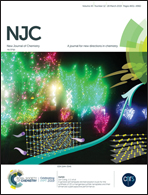Design of the NnH3n+1+ series of “non-metallic” superalkali cations†
Abstract
Species with a lower ionization energy than alkali atoms are referred to as superalkalis. Typical superalkalis include a central electronegative core with excess metal ligands. We propose a new series of “non-metallic” NnH3n+1+ superalkali cations based on the results of the MP2/6-311++G(d,p) computations. These cations are designed by successive replacement of H-ligands of ammonium cations (NH4+) by ammonium (NH4) moieties. The resulting NnH3n+1+ cations, which can be expressed in the form of [NH4⋯(n − 1)NH3]+ complexes, possess a number of unusual N–H⋯N type of partially covalent H-bonds, with the interaction energy in the range of 7.8–24.3 kcal mol−1. These cations are stable against loss of a proton (NnH3n + H+) and loss of ammonia [(n − 1)NH3 + NH4+]. The vertical electron attachment energies (EAvs) of NnH3n+1+ decrease monotonically from 4.39 eV for n = 1 to 2.39 eV for n = 5, which suggests their superalkali nature. This can be explained on the basis of electron localization on the core (central) N-atom (Qc), as the EAv correlates linearly with Qc. We have also demonstrated that this series may be continued to obtain new superalkali cations with even lower EAv, by exemplifying N9H28+ with an EAv of 1.84 eV. N9H28+ is stabilized by four partially covalent H-bonds (8.5 kcal mol−1 each) and four electrostatic H-bonds (0.4 kcal mol−1 each). This led to an exponential relation between EAv and n, which may provide an approximate EAv for any value of n in the NnH3n+1+ series.



 Please wait while we load your content...
Please wait while we load your content...